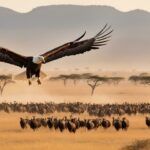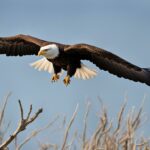You may have seen the majestic bald eagle soaring through the skies or perched atop a tree branch, but have you ever wondered about their dietary habits? Do they only feast on fish or are they omnivores? Understanding the feeding habits of these magnificent birds is essential to their conservation and the ecosystem they inhabit.
Key Takeaways:
- Bald eagles are known for their impressive aerial hunting skills and predominantly consume fish.
- They also consume birds, mammals, and carrion as part of their diet.
- Bald eagles’ feeding behavior and hunting techniques showcase their opportunistic and adaptable nature.
Understanding Bald Eagles’ Feeding Behavior
Before diving into the specifics of the bald eagle’s diet, it’s important to understand how they feed. As carnivorous birds, bald eagles use a variety of techniques to obtain their food.
One of their primary hunting techniques is to perch on a high branch or rock and scan the surrounding area for prey. Once they spot a potential meal, they will swoop down and grab it with their talons, often snatching it directly from the water’s surface.
In addition to hunting, bald eagles also forage for food. This involves searching for prey on the ground or in the water, often using their sharp eyesight to detect movement or ripples in the water.
Interestingly, young bald eagles are not as skilled at catching their own food and will sometimes resort to stealing food from other birds, such as ospreys or gulls.
Overall, bald eagles are impressive hunters and foragers, using their various techniques to obtain the food they need to survive in the wild.
The Diet of Bald Eagles
Bald eagles are opportunistic predators and can adapt their diet according to the availability of prey. Their primary food source is fish, which makes up about 70% of their diet. They are known to hunt for fish by flying over the water and then diving in to snatch them with their strong talons.
In addition to fish, bald eagles also consume other birds, such as ducks and geese, as well as small mammals such as rabbits and squirrels. They will also scavenge for carrion, including dead fish, birds, or mammals.
Interestingly, bald eagles have been known to steal prey from other birds, such as ospreys, by harassing them in mid-air until they drop their catch. Bald eagles have even been observed stealing food from other bald eagles.
Overall, the diet of a bald eagle is diverse and adaptable, depending on the available food sources in their habitat.
Hunting and Feeding Techniques
Bald eagles are known for their impressive hunting and feeding techniques. Their sharp talons and powerful beak allow them to capture and eat a variety of prey, making them one of the most successful carnivorous birds in North America.
When hunting for fish, which constitutes the bulk of their diet, bald eagles will often fly over bodies of water and scan the surface for their prey. Once they spot a fish, they will swoop down and, with incredible precision, snatch it from the water with their talons. They are also known to steal fish from other birds, such as ospreys.
In addition to fish, bald eagles will also hunt for birds and small mammals. They have been seen catching rabbits, squirrels, and even young deer. When hunting for these types of prey, they will typically ambush them from a perch, using their powerful wings to dive down and attack.
Bald eagles are also skilled scavengers, often feeding on carrion such as dead fish or animals. They are known for their scavenging behavior, which allows them to take advantage of the resources available in their environment.
Interestingly, bald eagles have been observed engaging in unique feeding behaviors that can appear almost playful. For example, they have been seen dropping hard-shelled prey, such as clams, onto rocks from a great height in order to break them open and access the meat inside.
Overall, the hunting and feeding techniques of bald eagles are truly impressive, allowing them to survive and thrive in a wide range of environments. Their adaptability and resourcefulness make them a vital part of the North American ecosystem.
The Role of Carrion in a Bald Eagle’s Diet
While bald eagles primarily consume fresh prey, they are also known to scavenge for carrion, showcasing their opportunistic feeding habits. Carrion, or the decaying flesh of dead animals, can make up a significant part of a bald eagle’s diet, especially during lean times when fresh prey is scarce.
Studies have shown that carrion can account for up to 28% of a bald eagle’s diet in some regions. Eagles will often scavenge on roadkill, fish refuse, and even corpses of other birds and mammals. This scavenging behavior not only ensures that bald eagles have a steady source of food during tough times but also plays an important role in maintaining ecosystem health.
Bald eagles help keep the environment clean by consuming carcasses, which reduces the chances of disease transmission and prevents the buildup of rotting organic matter. Their feeding behavior also allows other scavengers, such as vultures and coyotes, to access the remaining parts of the carcass that may be harder to consume for bald eagles.
Seasonal Variations in Diet
Bald eagles have a varied diet that changes with the seasons. During the breeding season, they consume more fish, which provide the necessary protein for their growing young. In the fall and winter, when migratory birds are passing through, eagles will also hunt waterfowl, such as ducks and geese.
As winter turns to spring, bald eagles will shift their focus to scavenging, as it is a lean time for hunting. They will look for carrion, such as roadkill, to supplement their diet. During the summer months, when prey is abundant, they will hunt more actively, diving into bodies of water to catch fish.
It’s important to note that seasonal variation can also occur based on location. Bald eagles in different regions may have different food sources available to them depending on the environment.
Food Scarcity and Migration Patterns
When food sources become scarce, bald eagles may migrate to seek out new feeding grounds. This is especially true in the northern regions of their range, where winter conditions can make finding food difficult. Some bald eagles will migrate as far south as Mexico to find areas with more abundant food sources.
It’s also worth noting that bald eagles are opportunistic feeders, meaning they will take advantage of any available food source. This includes raiding the nests of other birds and stealing food from other predators, such as ospreys and hawks.
The Impact of Human Activities on Bald Eagles’ Food Sources
Human activities have a significant impact on the food sources of bald eagles. Pollution and habitat destruction can disrupt their natural feeding patterns and threaten their survival. Many bald eagles rely on fish as their primary food source, and water pollution can reduce the availability and quality of fish in their habitats. This can lead to malnourishment and a decline in the bald eagle population.
Additionally, habitat destruction caused by human activities such as logging, mining, and urbanization can reduce the availability of prey and nesting sites for bald eagles. This can also lead to a decline in their population.
“Human activities have a significant impact on the food sources of bald eagles.”
Fortunately, conservation efforts have been successful in protecting the bald eagle population and their food sources. The banning of harmful pesticides like DDT in the 1970s helped to increase the number of bald eagles in North America.
Efforts to protect and restore habitats for bald eagles, such as the preservation of wetlands and the planting of trees, have also been successful. These efforts have allowed bald eagles to continue to thrive and play an important role in the ecosystem.
Overall, it is essential to understand the impact of human activities on bald eagles’ food sources. By taking steps to reduce pollution and preserve habitats, we can help ensure the survival of this magnificent species and maintain a healthy ecosystem.
Conservation Efforts and Success Stories
Thankfully, there have been numerous successful conservation efforts aimed at protecting bald eagles and their food sources. One such example is the banning of the pesticide DDT in the United States in the 1970s, which greatly improved the eagles’ reproductive success rates. Another success story is the reintroduction of bald eagles to areas where they had disappeared, such as the Channel Islands in California.
Efforts to protect and restore bald eagle habitats have also been successful. Along the Chesapeake Bay, for example, the U.S. Fish and Wildlife Service has worked with partners to conserve bald eagle nesting sites and wetland habitats, resulting in a steady increase in the local eagle population.
But the work is not done. Continued conservation efforts are necessary to maintain healthy bald eagle populations and protect their food sources. By supporting conservation organizations and participating in citizen-science efforts, you can help ensure that these majestic birds continue to thrive in the wild.
The Role of Bald Eagles in the Ecosystem
As top predators, bald eagles play a significant role in maintaining the balance of the ecosystem. Their feeding behavior contributes to keeping the population of other animals in check, preventing any one species from becoming too dominant and disrupting the balance. For example, their preference for fish allows for other bird species to have access to smaller aquatic animals. In this way, they indirectly contribute to the health and stability of the aquatic ecosystem.
Additionally, bald eagles are scavengers and play a vital role in cleaning up carrion from the environment. By consuming and removing dead animals, they help prevent the spread of disease and maintain environmental cleanliness. This behavior is particularly important in areas with high wildlife densities.
Furthermore, bald eagles are also indicators of overall ecosystem health. Their presence or absence in a given area can reflect the health of both the terrestrial and aquatic ecosystems. In instances where bald eagle populations have been threatened or have declined, it has been an important signal of the need to investigate and mitigate any environmental issues in the area.
Conclusion
So, are bald eagles omnivores? The answer is no. While they do occasionally scavenge for carrion and consume other types of prey, fish make up the majority of their diet, and they are considered carnivores.
Understanding the feeding habits of bald eagles is crucial for their conservation and the health of the ecosystem. Their hunting techniques, seasonal variations in diet, and role in maintaining a balanced food chain all demonstrate their ecological significance.
Protecting the Bald Eagle
Conservation efforts have helped protect bald eagles and their food sources, resulting in success stories of populations recovering. It’s important to continue these efforts to ensure the survival of this magnificent bird and its place in the ecosystem.
By learning more about bald eagles and their feeding habits, you can appreciate their significance and contribute to their protection. So the next time you spot a bald eagle soaring overhead, you’ll know a little more about what they eat and their role in the ecosystem.
Can Bald Eagles Survive on a Herbivorous Diet?
Can bald eagles survive on a herbivorous diet? Recent research on bald eagles’ dietary preferences revealed now suggests otherwise. These majestic birds of prey are primarily carnivorous, relying on a diet of fish and small mammals. Their sharp beaks and powerful talons are specifically designed for capturing and consuming prey, making a herbivorous diet unlikely for their survival.
FAQ
Q: Are bald eagles omnivores?
A: No, bald eagles are not omnivores. They are primarily carnivorous and their diet consists mainly of fish.
Q: What do bald eagles eat?
A: Bald eagles primarily eat fish, particularly those found in lakes, rivers, and coastal areas. However, they also consume birds, mammals, and carrion.
Q: Do bald eagles scavenge for food?
A: Yes, bald eagles are opportunistic feeders and will scavenge for carrion when available. This allows them to take advantage of additional food sources.
Q: How do bald eagles hunt their prey?
A: Bald eagles employ various hunting techniques, including aerial acrobatics and swooping down to snatch prey from water surfaces. Their sharp talons and strong beaks assist in capturing and securing their food.
Q: Do bald eagles’ feeding habits change throughout the year?
A: Yes, the feeding habits of bald eagles do change seasonally. Depending on factors such as prey availability and migration patterns, their food preferences may vary.
Q: How do human activities impact bald eagles’ food sources?
A: Human activities, such as pollution and habitat destruction, can disrupt bald eagles’ food sources. This poses a threat to their survival and highlights the importance of conservation efforts to protect their habitats.
Q: Are there any success stories in bald eagle conservation?
A: Yes, there have been successful conservation efforts that have helped protect bald eagles and their food sources. These efforts have led to population recoveries and highlight the importance of ongoing conservation work.
Q: What is the role of bald eagles in the ecosystem?
A: Bald eagles play a crucial role in maintaining a balanced food chain and ecosystem health. Their feeding behavior helps control populations of prey species and contributes to the overall ecological balance.











